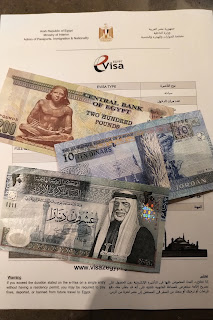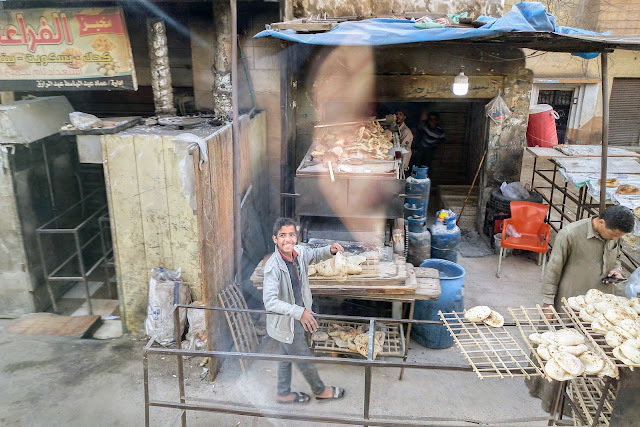Feb. 29: Abu Simbel & Turning Downstream
Docking in Aswan overnight positioned us for an early but short drive to the airport for the first flight of the day to Abu Simbel, one of the southernmost towns in Egypt only some 40 km from the border of Sudan. A 5 am departure gave us plenty of time for the 40 minute flight along the shore of Lake Nasser. To the right of the plane was the barren Sahara Desert.
The temples at Abu Simbel are important from both historic and engineering standpoints. When Lake Nasser was created by the building of the Aswan High Dam, these two temples would be flooded and ultimately destroyed by the water. Fifty countries participated in the project which involved making precise cuts in the giant stones, transporting the cut stones 84 metres higher, and reassembling hem in exactly the same orientation as the original buildings.
The larger of the two temples is dedicated to Ramses II, or Ramses the Great. The smaller building is a temple he built to honour his wife, Nefertari.
Before building the temples, Ramses led his armies against the Hittite forces in the Battle of Kadesh. This wasn’t exactly, a win for Ramses, but he did show his skill as a military leader turning back a surprise attack by the Hittites who far outnumbered the Egyptians.
The six massive statues of Ramses that adorn the outside of the building are 22 metres high. People do not even come up to the height of his feet. Six smaller statues stand in front of the temple for Nefertari, four of them being images of Ramses and only two representing his wife.
The interior images of the main temple depict Ramses as a great military hero leading his troops and smiting his enemies. The entry to the temple shows rows of captives, their arms tied behind their backs. Inside, the main hall is adorned with two more rows of Ramses statues. On the walls and columns, Ramses rides his chariot at the head of his army, using a bow, spear, and other weapons. Other images have him interacting with the gods.
The carved images are still well-defined and many still show the original paint. On the back wall of the temple, directly in line with the main door, in a small room, four equally sized statues sit on a platform. Three of these are gods and one is Ramses himself, the same size possibly indicating his view of his own importance. On 2 days each year, the sun coming in the main door illuminates 3 of the statues. The statue on the left is the god of darkness and the underworld. His images remains in the dark. In the temple's original location, the illumination dates were Feb. 21 and Oct. 21. After the reconstruction, the dates were Feb. 22 and Oct. 22. Perhaps the engineers’ calculations were a bit off. When we visited, On Feb. 29, three and a half statues were illuminated.
Interior views of the smaller temple. In the main room, the female god Hat-Hor tops the columns. She is the god of love and perhaps one of Nefertari's favourites.
Interior views of the smaller temple. In the main room, the female god Hat-Hor tops the columns. She is the god of love and perhaps one of Nefertari's favourites.
We reversed our morning travel; 2 bus rides and a brief flight got us back to the ship by lunch. The captain started our return trip northward, stopping briefly at Kom Ombo again for a few folks who recently boarded. Taking advantage of the port to get some walking done we went on shore and saw a fellow with 2 cobras on the sidewalk. For $20 USD, he would feed a mouse to one of his snakes. We opted not to pay for the reptile's lunch.
Port stop near Kom Ombo temple
With such a full schedule and the rather slow pace of exploring the temples, getting a lot of daily walking done is a challenge.
Port stop near Kom Ombo temple
With such a full schedule and the rather slow pace of exploring the temples, getting a lot of daily walking done is a challenge.

















Comments
Post a Comment